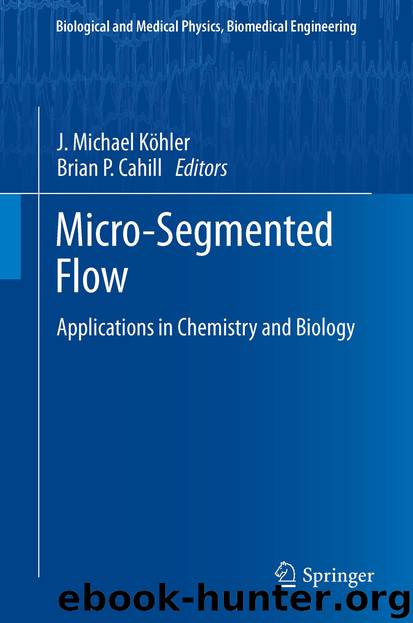Micro-Segmented Flow by J. Michael Köhler & Brian P. Cahill

Author:J. Michael Köhler & Brian P. Cahill
Language: eng
Format: epub
Publisher: Springer Berlin Heidelberg, Berlin, Heidelberg
6.6.5 Membrane/Mesh Microreactor
Two kinds of membrane/mesh microreactors can be distinguished. Abdallah et al. [139] have used a utilized a mesh with 5 m bores to stabilize the gas–liquid interface with an area of , while the catalyst was deposited on the liquid-side wall. Shaw has used Pt, Pd or Rh-coated meshes for catalysis of liquid–liquid reduction of nitrobenzene and compared this reactor with Abdallahs concepts [140]. Zero conversion was observed, when the catalyst was deposited on the wall of one phase exclusively, but 12 % conversion were obtained with the Pt-coated mesh. This indicates that “in-series”-transfer through phases that are separated by a mesh requires short diffusive pathways. Anyway, membrane and mesh microreactors provide a low amount of catalyst in the reactor. That is applicable for very fast, highly endo- /exothermic or selectivity-sensitive reactions. But the incipient studies provide no clear insight into the mass transfer performance. Good control of temperature and residence time as well as low pressure drop and inherent phase separation are further beneficial features. Fabrication and catalyst recovery can be laborious or impossible. On the other hand, the reactor might be robust in terms of fluid-dynamic conditions, as long as wetting/contact hysteresis effects do not promote break-through [10]. Kulkarni et al. indicate narrow residence time distribution in gas–liquid mesh microreactors, but Peclet number varies from 0.5–1 and 0.5–2 due to contact angle hysteresis [141]. In conclusion, membrane/mesh microreactors might serve as an alternative for wall-coated microreactors, as these types are largely comparable, except for the inherent phase separation provided by the membrane/mesh microreactor.
The global picture on alternative microreactor concepts reveals that the suspension slug flow microreactor takes an intermediate position in terms of catalytic load, heat and mass transfer. It offers a good compromise of numerous design criteria - making it attractive for many reactions. Simple fabrication, low installation costs and flexible adaption to multiple purposes support this rating.
Download
This site does not store any files on its server. We only index and link to content provided by other sites. Please contact the content providers to delete copyright contents if any and email us, we'll remove relevant links or contents immediately.
| Automotive | Engineering |
| Transportation |
Whiskies Galore by Ian Buxton(41935)
Introduction to Aircraft Design (Cambridge Aerospace Series) by John P. Fielding(33085)
Small Unmanned Fixed-wing Aircraft Design by Andrew J. Keane Andras Sobester James P. Scanlan & András Sóbester & James P. Scanlan(32763)
Craft Beer for the Homebrewer by Michael Agnew(18194)
Turbulence by E. J. Noyes(7977)
The Complete Stick Figure Physics Tutorials by Allen Sarah(7334)
Kaplan MCAT General Chemistry Review by Kaplan(6897)
The Thirst by Nesbo Jo(6877)
Bad Blood by John Carreyrou(6581)
Modelling of Convective Heat and Mass Transfer in Rotating Flows by Igor V. Shevchuk(6406)
Learning SQL by Alan Beaulieu(6235)
Weapons of Math Destruction by Cathy O'Neil(6206)
Man-made Catastrophes and Risk Information Concealment by Dmitry Chernov & Didier Sornette(5951)
Digital Minimalism by Cal Newport;(5699)
Life 3.0: Being Human in the Age of Artificial Intelligence by Tegmark Max(5506)
iGen by Jean M. Twenge(5384)
Secrets of Antigravity Propulsion: Tesla, UFOs, and Classified Aerospace Technology by Ph.D. Paul A. Laviolette(5330)
Design of Trajectory Optimization Approach for Space Maneuver Vehicle Skip Entry Problems by Runqi Chai & Al Savvaris & Antonios Tsourdos & Senchun Chai(5036)
Pale Blue Dot by Carl Sagan(4949)
